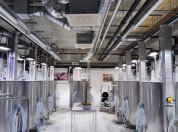Onderzoeksfaciliteiten
Bij het NIOO zijn veel belangrijke onderzoeksfaciliteiten voor ecologisch onderzoek te vinden: van experimentele mini-meren tot onderzoeksboten, en van living labs tot collecties.
Filteren op
Infrastructuurtype
Landschapstype
Active filters
Zoekresultaten
-
Hole-breeding passerines monitoring: Liesbos
Liesbos is one of four areas in NIOO-AnE's long-term monitoring research on great tits and other bird species that started in 1955. It consists of a large forest area of about 100 ha of deciduous trees, mainly oak, on rich sandy-loam soil.
-
Hole-breeding passerines monitoring: Oosterhout
Oosterhout is the last of four areas in NIOO-AnE's long-term monitoring research on great tits and other bird species. Research there started in 1956, one year after the other three areas. It consists of deciduous forest of mainly oak trees on a country estate of about 8 ha, and has a rich clay-sandy-loam soil. Oosterhout has around 150 nestboxes.
-
Hole-breeding passerines monitoring: Vlieland
Vlieland is one of four areas in NIOO-AnE's long-term monitoring research on great tits and other bird species that started in 1955. It consists of several smaller forest areas, which together cover about 250 ha of mainly conifers and oak on poor sandy soil. As Vlieland is an island in the Wadden Sea, the area stands completely on its own. Important population questions in NIOO's long term research are/were studied here.
-
Land van Ons - Warmond
The foundation 'Land van Ons' has obtained a peat meadow area near Leiden to increase biodiversity in this intensively used agricultural area. The goal is not to recreate nature, but to develop sustainable agricultural use of this land with the goal of increasing biodiversity in the area and developing management strategies that optimise its ecological, economic and recreational value.
-
Limnotrons
The limnotrons are twelve stainless steel indoor mesocosms with a high level of control. The dimensions are: 0.97 m in diameter, 1.32 m (side) and 1.37 m (centre) depth, and a maximum volume of 922 L. In addition to the possibility of sampling vertically with specifically designed integrated water samplers, sampling can also be done by using the sampling ports positioned at three depths. The vessels are equipped with automatic sensors (oxygen, temperature, light), which can make pre-programmed depth profiles.
-
LTSER-platform Dutch Wadden Sea
The Long-Term Socio-Ecological research platform Dutch Wadden Sea area is a large coastal area bordering the north of the Netherlands.
-
Marker Wadden
The Marker Wadden is a newly constructed archipelago in lake Markermeer, which aims to improve the lake’s degrading food web by stimulating primary productivity. The archipelago consists of five islands that add a currently missing habitat type to the lake: shallow, sheltered waters with high nutrient availability and gradual land-water transitions.
-
Mesocosms for soil-plant-insect interactions
A total of 40 mesocosms are distributed in five rows of eight mesocosms with a spacing of 0.5 m between them. In spring/summer we grow plant species that are currently expanding their range within Europe and species that belong to the same genus while being native in the Netherlands.
-
Microcosms
The Netherlands Institute of Ecology (NIOO-KNAW) houses 36x10L microcosms (transparent polycarbonate carboys; NALGENE, Rochester, USA) for plankton research. The microcosms can be temperature-controlled in water baths (at 0.5 °C temperature resolution), and automatically stirred through magnetic stirrers mounted below the water baths.
-
Molecular laboratory
The molecular laboratories offer a wide range of facilities needed for handling, preparing and analysing a wide variety of DNA and/or RNA samples. The lab is well-equipped, and in addition to the general molecular laboratory there are several specialised laboratories such as an MLII Lab, an RNA Lab and a PCR lab with UV-cupboards.
-
Nematode extraction & determination
Nematode communities play an important role in soil ecology research. To analyse different type of plant-soil nematodes, NIOO has a facility for extracting soil and root nematodes by Oostenbrink funnel and mistifier.
-
NutNet Planken-Wambuis
Two of the most pervasive human impacts on ecosystems are alteration of global nutrient budgets and changes in the abundance and identity of consumers. In spite of the global impacts of these human activities, there have been no globally coordinated experiments to quantify the general impacts on ecological systems. The Nutrient Network (NutNet) is a grassroots, global research effort to address these questions within a coordinated research network comprised of more than 130 grassland sites worldwide.
